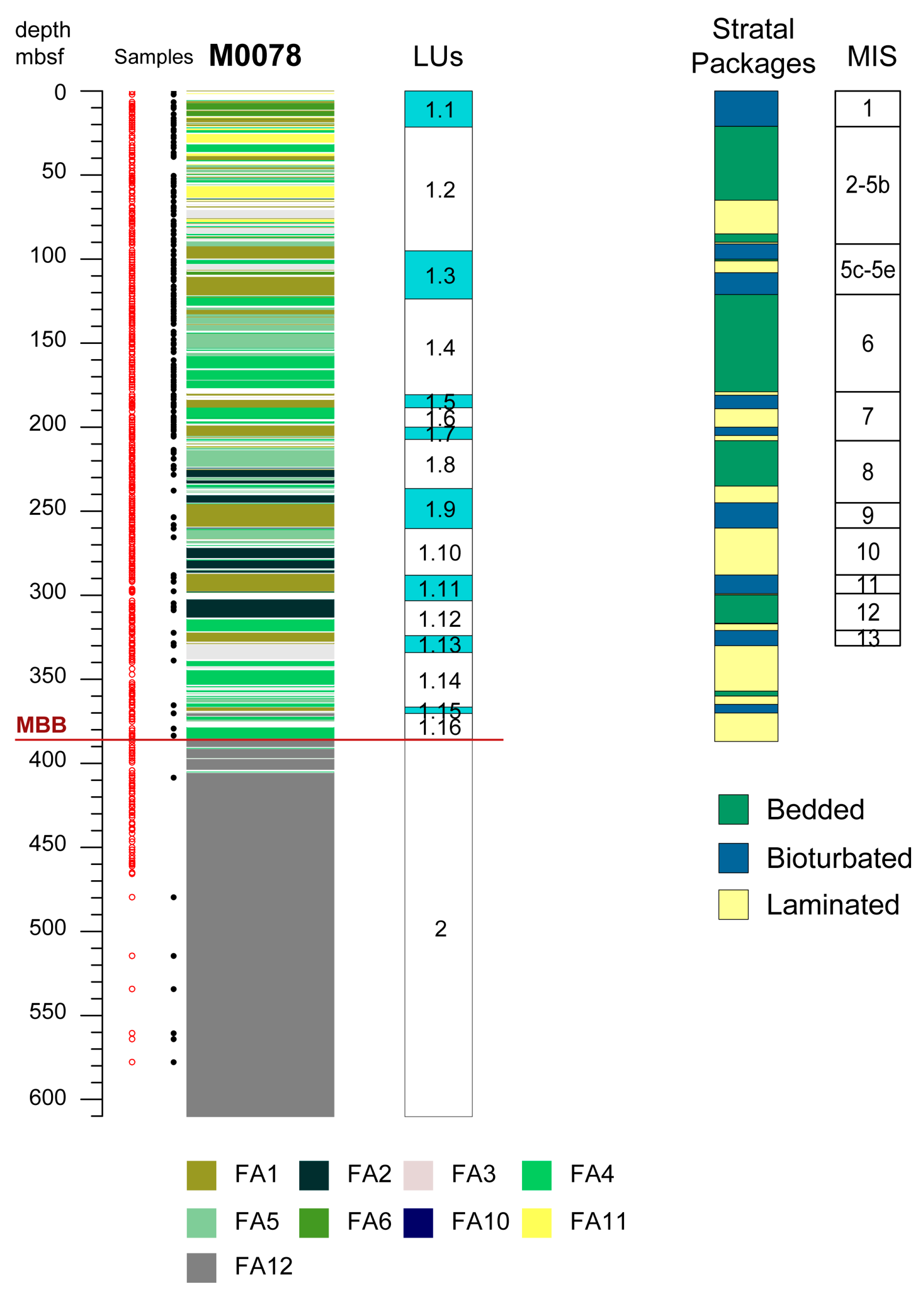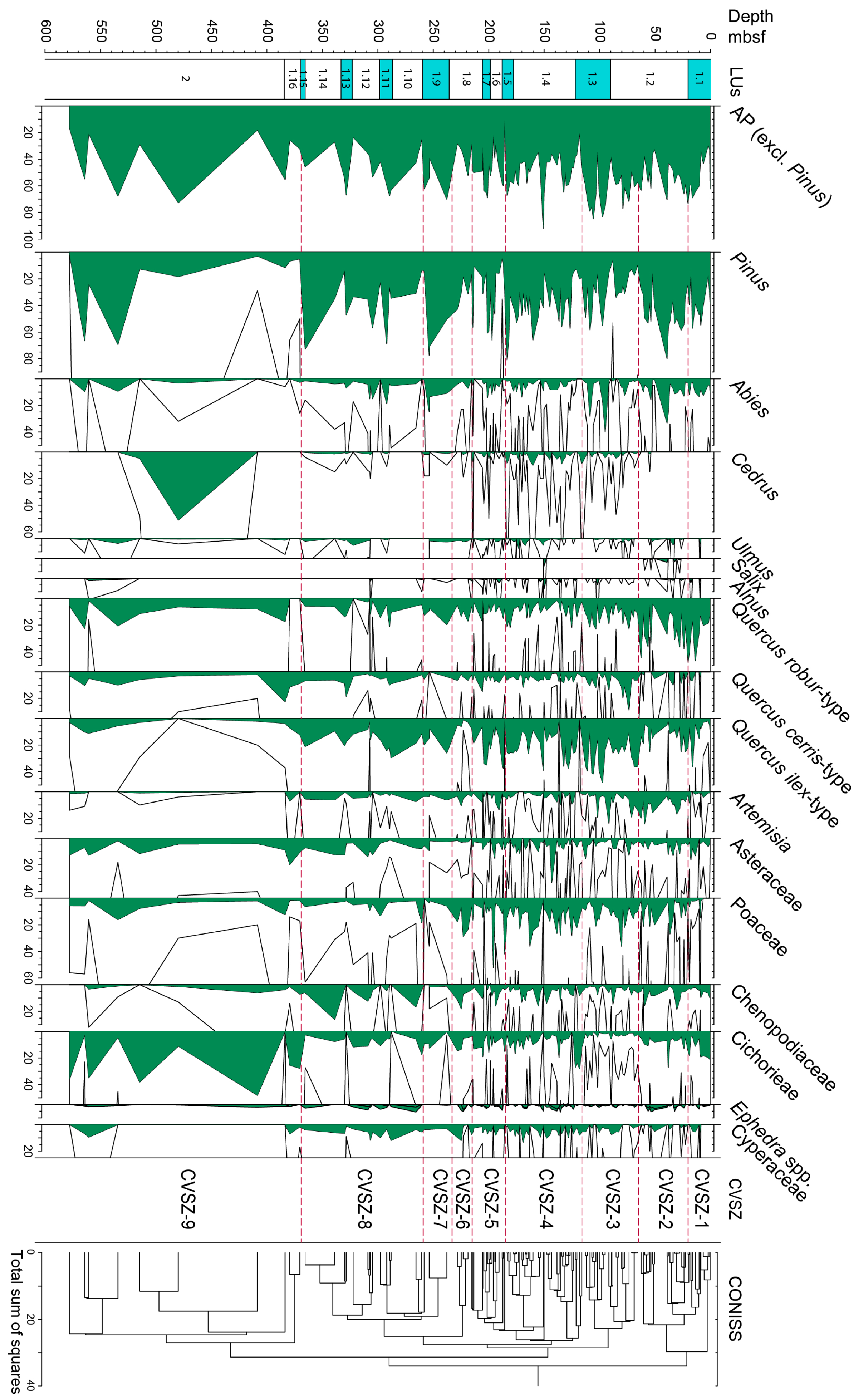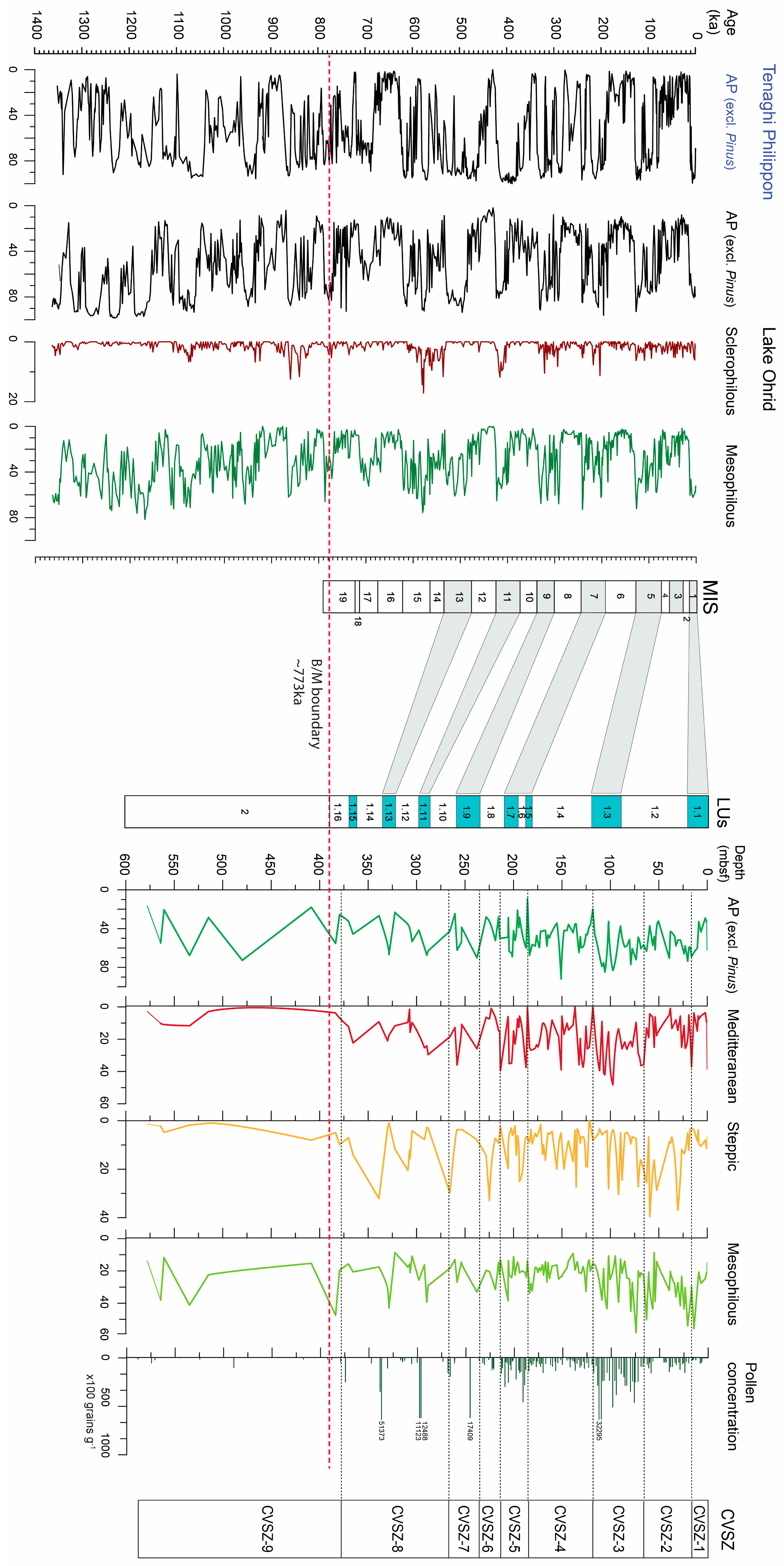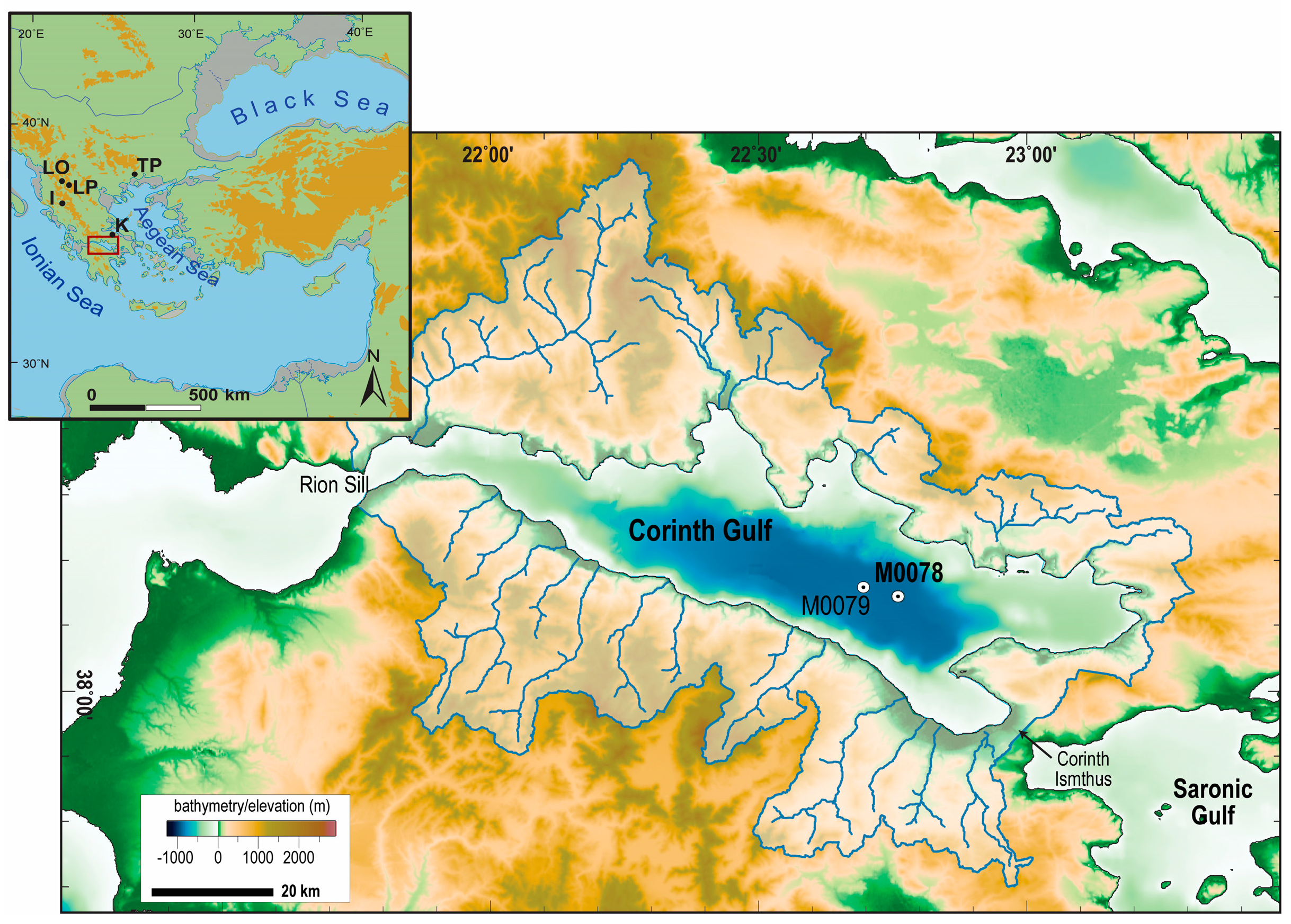Vegetation Composition in a Typical Mediterranean Setting (Gulf of Corinth, Greece) during Successive Quaternary Climatic Cycles
Abstract
1. Introduction
2. Materials and Methods
2.1. Chronology

2.2. Palynology and Biome Reconstruction
3. Results
4. Discussion
4.1. Vegetation and Climatic Inferences
4.1.1. CVSZ-9


4.1.2. CVSZ-8
4.1.3. CVSZ-7
4.1.4. CVSZ-6
4.1.5. CVSZ-5

4.1.6. Zone CVSZ-4
4.1.7. CVSZ-3
4.1.8. CVSZ-2
4.1.9. CVSZ-1
4.2. Comparison with Regional Pollen Records
5. Conclusions
Supplementary Materials
Author Contributions
Funding
Institutional Review Board Statement
Informed Consent Statement
Data Availability Statement
Acknowledgments
Conflicts of Interest
References
- Tzedakis, P.C.; Andrieu, V.; De Beaulieu, J.L.; Crowhurst, S.; Follieri, M.; Hooghiemstra, H.; Magri, D.; Reille, M.; Sadori, L.; Shackleton, N.J.; et al. Comparison of terrestrial and marine records of changing climate of the last 500,000 years. Earth Planet. Sci. Lett. 1997, 150, 171–176. [Google Scholar] [CrossRef]
- Follieri, M.; Magri, D.; Sadori, L. Pollen stratigraphical synthesis from Valle di Castiglione (Roma). Quat. Int. 1989, 3–4, 81–84. [Google Scholar] [CrossRef]
- Sánchez Goñi, M.F.; Eynaud, F.; Turon, J.L.; Shackleton, N.J. High resolution palynological record off the Iberian margin: Direct land-sea correlation for the Last Interglacial complex. Earth Planet. Sci. Lett. 1999, 171, 123–137. [Google Scholar] [CrossRef]
- Reille, M.; De Beaulieu, J.-L.; Svobodova, H.; Andrieu-Ponel, V.; Goeury, C. Pollen analytical biostratigraphy of the last five climatic cycles from a long continental sequence from the Velay region (Massif Central, France). J. Quat. Sci. 2000, 15, 665–685. [Google Scholar] [CrossRef]
- Tzedakis, P.C. Hierarchical Biostratigraphical Classification of Long Pollen Sequences. J. Quat. Sci. 1994, 9, 257–259. [Google Scholar] [CrossRef]
- Pross, J.; Koutsodendris, A.; Christanis, K.; Fischer, T.; Fletcher, W.J.; Hardiman, M.; Kalaitzidis, S.; Knipping, M.; Kotthoff, U.; Milner, A.M.; et al. The 1.35-Ma-Long Terrestrial Climate Archive of Tenaghi Philippon, Northeastern Greece: Evolution, Exploration, and Perspectives for Future Research. Newsl. Stratigr. 2015, 48, 253–276. [Google Scholar] [CrossRef]
- Sadori, L.; Koutsodendris, A.; Panagiotopoulos, K.; Masi, A.; Bertini, A.; Combourieu-Nebout, N.; Francke, A.; Kouli, K.; Joannin, S.; Mercuri, A.M.; et al. Pollen-Based Paleoenvironmental and Paleoclimatic Change at Lake Ohrid (South-Eastern Europe) during the Past 500 Ka. Biogeosciences 2016, 13, 1423–1437. [Google Scholar] [CrossRef]
- Wijmstra, T.A. Palynology of the First 30 Metres of a 120 m Deep Section in Northern Greece. Acta Bot. Neerl. 1969, 18, 511–527. [Google Scholar] [CrossRef]
- Okuda, M.; Yasuda, Y.; Setoguchi, T. Middle to Late Pleistocene Vegetation History and Climatic Changes at Lake Kopais, Southeast Greece. Boreas 2001, 30, 73–82. [Google Scholar] [CrossRef]
- Donders, T.; Panagiotopoulos, K.; Koutsodendris, A.; Bertini, A.; Maria Mercuri, A.; Masi, A.; Combourieu-Nebout, N.; Joannin, S.; Kouli, K.; Kousis, I.; et al. 1.36 Million Years of Mediterranean Forest Refugium Dynamics in Response to Glacial-Interglacial Cycle Strength. Proc. Natl. Acad. Sci. USA 2021, 118, e2026111118. [Google Scholar] [CrossRef] [PubMed]
- Tzedakis, P.C.; Hooghiemstra, H.; Pälike, H. The Last 1.35 Million Years at Tenaghi Philippon: Revised Chronostratigraphy and Long-Term Vegetation Trends. Quat. Sci. Rev. 2006, 25, 3416–3430. [Google Scholar] [CrossRef]
- Tzedakis, P.C.; McManus, J.F.; Hooghiemstra, H.; Oppo, D.W.; Wijmstra, T.A. Comparison of changes in vegetation in northeast Greece with records of climate variability on orbital and suborbital frequencies over the last 450,000 years. Earth Planet. Sci. Lett. 2003, 212, 197–212. [Google Scholar] [CrossRef]
- Panagiotopoulos, K.; Holtvoeth, J.; Kouli, K.; Marinova, E.; Francke, A.; Cvetkoska, A.; Jovanovska, E.; Lacey, J.H.; Lyons, E.T.; Buckel, C.; et al. Insights into the evolution of the young Lake Ohrid ecosystem and vegetation succession from a southern European refugium during the Early Pleistocene. Quat. Sci. Rev. 2020, 227, 106044. [Google Scholar] [CrossRef]
- Petit, R.J.; Aguinagalde, I.; De Beaulieu, J.L.; Bittkau, C.; Brewer, S.; Cheddadi, R.; Ennos, R.; Fineschi, S.; Grivet, D.; Lascoux, M.; et al. Glacial refugia: Hotspots but not melting pots of genetic diversity. Science 2003, 300, 1563–1565. [Google Scholar] [CrossRef]
- Blonder, J.; Aronson, J.; Bodiou, J.Y.; Boeuf, G. The Mediterranean Region: Biological Diversity in Space and Time; Oxford University Press: Oxford, UK, 2010. [Google Scholar]
- Tzedakis, P.C.; Lawson, I.T.; Frogley, M.R.; Hewitt, G.M.; Preece, R.C. Buffered Tree Population Changes in a Quaternary Refugium: Evolutionary Implications. Science 2002, 297, 2044–2047. [Google Scholar] [CrossRef] [PubMed]
- Tzedakis, P.C.; Frogley, M.R.; Lawson, I.T.; Preece, R.C.; Cacho, I.; de Abreu, L. Ecological Thresholds and Patterns of Millennial-Scale Climate Variability: The Response of Vegetation in Greece during the Last Glacial Period. Geology 2004, 32, 109–112. [Google Scholar] [CrossRef]
- Panagiotopoulos, K.; Böhm, A.; Leng, M.J.; Wagner, B.; Schäbitz, F. Climate Variability over the Last 92 Ka in SW Balkans from Analysis of Sediments from Lake Prespa. Clim. Past 2014, 10, 643–660. [Google Scholar] [CrossRef]
- Tzedakis, P.C. The Last Climatic Cycle at Kopais, Central Greece. J. Geol. Soc. Lond. 1999, 156, 425–434. [Google Scholar] [CrossRef]
- Leontaritis, A.D.; Kouli, K.; Pavlopoulos, K. The Glacial History of Greece: A Comprehensive Review. Mediterr. Geosci. Rev. 2020, 2, 65–90. [Google Scholar] [CrossRef]
- Sindosi, O.A.; Bartzokas, A.; Kotroni, V.; Lagouvardos, K. Influence of Orography on Precipitation Amount and Distribution in NW Greece; A Case Study. Atmos. Res. 2015, 152, 105–122. [Google Scholar] [CrossRef]
- Trigas, P.; Tsiftsis, S.; Tsiripidis, I.; Iatrou, G. Distribution Patterns and Conservation Perspectives of the Endemic Flora of Peloponnese (Greece). Folia Geobot. 2012, 47, 421–439. [Google Scholar] [CrossRef]
- McNeill, L.C.; Shillington, D.J.; Carter, G.D.O.; Everest, J.D.; Le Ber, E.; Collier, R.E.L.; Cvetkoska, A.; De Gelder, G.; Diz, P.; Doan, M.-L.; et al. Corinth Active Rift Development. In Proceedings of the International Ocean Discovery Program; International Ocean Discovery Program: College Station, TX, USA, 2019; Volume 381. [Google Scholar] [CrossRef]
- Shillington, D.J.; McNeill, L.C.; Carter, G.D.O.; the Expedition 381 Participants. Expedition 381 Preliminary Report: Corinth Active Rift Development; International Ocean Discovery Program Preliminary Report; International Ocean Discovery Program: College Station, TX, USA, 2019. [Google Scholar] [CrossRef]
- McNeill, L.C.; Shillington, D.J.; Carter, G.D.O.; Everest, J.D.; Gawthorpe, R.L.; Miller, C.; Phillips, M.P.; Collier, R.E.L.; Cvetkoska, A.; de Gelder, G.; et al. High-Resolution Record Reveals Climate-Driven Environmental and Sedimentary Changes in an Active Rift. Sci. Rep. 2019, 9, 3116. [Google Scholar] [CrossRef] [PubMed]
- Gawthorpe, R.L.; Fabregas, N.; Pechlivanidou, S.; Ford, M.; Collier, R.E.L.; Carter, G.D.O.; McNeill, L.C.; Shillington, D.J. Late Quaternary Mud-Dominated, Basin-Floor Sedimentation of the Gulf of Corinth, Greece: Implications for Deep-Water Depositional Processes and Controls on Syn-Rift Sedimentation. Basin Res. 2022, 34, 1567–1600. [Google Scholar] [CrossRef]
- Singer, B.S. A Quaternary Geomagnetic Instability Time Scale. Quat. Geochronol. 2014, 21, 29–52. [Google Scholar] [CrossRef]
- Agnini, C.; Monechi, S.; Raffi, I. Calcareous Nannofossil Biostratigraphy: Historical Background and Application in Cenozoic Chronostratigraphy. Lethaia 2017, 50, 447–463. [Google Scholar] [CrossRef]
- Maffione, M.; Herrero-Bervera, E. A Relative Paleointensity (RPI)-Calibrated Age Model for the Corinth Syn-Rift Sequence at IODP Hole M0079A (Gulf of Corinth, Greece). Front. Earth Sci. 2022, 10, 813958. [Google Scholar] [CrossRef]
- Smit, A. A Scanning Electron Microscopical Study of the Pollen Morphology in the Genus Quercus. Acta Bot. Neerl. 1973, 22, 655–665. [Google Scholar] [CrossRef]
- Beug, H.J. Leitfaden der Pollenbestimmung für Mitteleuropa und Angrenzende Gebiete (Guide to the Pollen Analysis for Central Europe and the Adjacent Areas); Verlag Dr. Friedrich Pfeil: Munchen, Germany, 2004. [Google Scholar]
- Chester, P.I.; Raine, J.I. Pollen and Spore Keys for Quaternary Deposits in the Northern Pindos Mountains, Greece. Grana 2001, 40, 299–387. [Google Scholar] [CrossRef]
- Reille, M. Long Pleistocene Pollen Records from the Praclaux Crater, South-Central France. Quat. Res. 1995, 44, 205–215. [Google Scholar] [CrossRef]
- Reille, M.; Andrieu, V.R.; De Beaulieu, J.-L.; Guenet, P.; Goeury, C. A Long Pollen Record from Lac Du Bouchet, Massif Central, France: For the Period ca. 325 to 100 Ka BP (OIS 9c to OIS 5e). Quat. Sci. Rev. 1998, 17, 1107–1123. [Google Scholar] [CrossRef]
- Reille, M. New Pollen-analytical Researches in Corsica: The Problem of Quercus Ilex L. and Erica Arborea L., the Origin of Pinus Halepensis Miller Forests. New Phytol. 1992, 122, 359–378. [Google Scholar] [CrossRef] [PubMed]
- Grimm, E.C. CONISS: A FORTRAN 77 Program for Stratigraphically Constrained Cluster Analysis by the Method of Incremental Sum of Squares. Comput. Geosci. 1987, 13, 13–35. [Google Scholar] [CrossRef]
- Prentice, I.C.; Cramer, W.; Harrison, S.P.; Leemans, R.; Monserud, R.A.; Solomon, A.M. Special Paper: A Global Biome Model Based on Plant Physiology and Dominance, Soil Properties and Climate. Source J. Biogeogr. 1992, 19, 117–134. [Google Scholar] [CrossRef]
- Prentice, I.C.; Guiot, J.; Huntley, B.; Jolly, D.; Cheddadi, R. Reconstructing Biomes from Palaeoecological Data: A General Method and Its Application to European Pollen Data at 0 and 6 Ka. Clim. Dyn. 1996, 12, 185–194. [Google Scholar] [CrossRef]
- Marinova, E.; Harrison, S.P.; Bragg, F.; Connor, S.; de Laet, V.; Leroy, S.A.G.; Mudie, P.; Atanassova, J.; Bozilova, E.; Caner, H.; et al. Pollen-Derived Biomes in the Eastern Mediterranean–Black Sea–Caspian-Corridor. J. Biogeogr. 2018, 45, 484–499. [Google Scholar] [CrossRef]
- Fatourou, E.; Kafetzidou, A.; Marret, F.; Panagiotopoulos, K.; Kouli, K. Late Quaternary Ponto-Caspian dinoflagellate cyst assemblages from the Gulf of Corinth, Central Greece (eastern Mediterranean Sea). Mar. Micropaleontol. 2023, 179, 102211. [Google Scholar] [CrossRef]
- Koutsodendris, A.; Kousis, I.; Peyron, O.; Wagner, B.; Pross, J. The Marine Isotope Stage 12 pollen record from Lake Ohrid (SE Europe): Investigating short-term climate change under extreme glacial conditions. Quat. Sci. Rev. 2019, 221, 105873. [Google Scholar] [CrossRef]
- Fletcher, W.J.; Sánchez Goñi, M.F.; Allen, J.R.M.; Cheddadi, R.; Combourieu-Nebout, N.; Huntley, B.; Lawson, I.; Londeix, L.; Magri, D.; Margari, V.; et al. Millennial-scale variability during the last glacial in vegetation records from Europe. Quat. Sci. Rev. 2010, 29, 2839–2864. [Google Scholar] [CrossRef]
- Leontaritis, A.D.; Pavlopoulos, K.; Marrero, S.M.; Ribolini, A.; Hughes, P.D.; Spagnolo, M. Glaciations on ophiolite terrain in the North Pindus Mountains, Greece: New geomorphological insights and preliminary 36Cl exposure dating. Geomorphology 2022, 413, 108335. [Google Scholar] [CrossRef]
- Allard, J.L.; Hughes, P.D.; Woodward, J.C.; Fink, D.; Simon, K.; Wilcken, K.M. Late Pleistocene glaciers in Greece: A new 36Cl chronology. Quat. Sci. Rev. 2020, 245, 106528. [Google Scholar] [CrossRef]
- Roucoux, K.H.; Tzedakis, P.C.; de Abreu, L.; Shackleton, N.J. 24. Fine-tuning the land-ocean correlation for the late middle pleistocene of Southern Europe. Dev. Quat. Sci. 2007, 7, 359–373. [Google Scholar] [CrossRef]
- Fletcher, W.J.; Müller, U.C.; Koutsodendris, A.; Christanis, K.; Pross, J. A centennial-scale record of vegetation and climate variability from 312 to 240ka (Marine Isotope Stages 9c-a, 8 and 7e) from Tenaghi Philippon, NE Greece. Quat. Sci. Rev. 2013, 78, 108–125. [Google Scholar] [CrossRef]
- Litt, T.; Pickarski, N.; Heumann, G.; Stockhecke, M.; Tzedakis, P.C. A 600,000 year long continental pollen record from Lake Van, eastern Anatolia (Turkey). Quat. Sci. Rev. 2014, 1–12. [Google Scholar] [CrossRef]
- Tzedakis, P.C.; Andrieu, V.; de Beaulieu, J.L.; Birks, H.J.B.; Crowhurst, S.; Follieri, M.; Hooghiemstra, H.; Magri, D.; Reille, M.; Sadori, L.; et al. Establishing a terrestrial chronological framework as a basis for biostratigraphical comparisons. Quat. Sci. Rev. 2001, 20, 1583–1592. [Google Scholar] [CrossRef]
- Roucoux, K.H.; Tzedakis, P.C.; Frogley, M.R.; Lawson, I.T.; Preece, R.C. Vegetation history of the marine isotope stage 7 interglacial complex at Ioannina, NW Greece. Quat. Sci. Rev. 2008, 27, 1378–1395. [Google Scholar] [CrossRef]
- Milner, A.M.; Roucoux, K.H.; Collier, R.E.L.; Müller, U.C.; Pross, J.; Tzedakis, P.C. Vegetation responses to abrupt climatic changes during the Last Interglacial Complex (Marine Isotope Stage 5) at Tenaghi Philippon, NE Greece. Quat. Sci. Rev. 2016, 154, 169–181. [Google Scholar] [CrossRef]
- Sinopoli, G.; Masi, A.; Regattieri, E.; Wagner, B.; Francke, A.; Peyron, O.; Sadori, L. Palynology of the Last Interglacial Complex at Lake Ohrid: Palaeoenvironmental and palaeoclimatic inferences. Quat. Sci. Rev. 2018, 180, 177–192. [Google Scholar] [CrossRef]
- Kyrikou, S.; Kouli, K.; Triantaphyllou, M.v.; Dimiza, M.D.; Gogou, A.; Panagiotopoulos, I.P.; Anagnostou, C.; Karageorgis, A.P. Late Glacial and Holocene Vegetation Patterns of Attica: A High-Resolution Record from Elefsis Bay, Southern Greece. Quat. Int. 2020, 545, 28–37. [Google Scholar] [CrossRef]
- Digerfeldt, G.; Olsson, S. Reconstruction of Lake-Level Changes in Lake Xinias, Central Greece, during the Last 40 000 Years. Palaeogeogr. Palaeoclimatol. Palaeoecol. 2000, 158, 65–82. [Google Scholar] [CrossRef]
- Kouli, K.; Dermitzakis, M.D. Lake Orestiás (Kastoria, Northern Greece). Grana 2010, 49, 154–156. [Google Scholar] [CrossRef]
- Lawson, I.T.; Al-Omari, S.; Tzedakis, P.C.; Bryant, C.L.; Christanis, K. Lateglacial and Holocene Vegetation History at Nisi Fen and the Boras Mountains, Northern Greece. Holocene 2005, 15, 873–887. [Google Scholar] [CrossRef]
- Panagiotopoulos, K.; Aufgebauer, A.; Schäbitz, F.; Wagner, B. Vegetation and Climate History of the Lake Prespa Region since the Lateglacial. Quat. Int. 2013, 293, 157–169. [Google Scholar] [CrossRef]
- Weiberg, E.; Unkel, I.; Kouli, K.; Holmgren, K.; Avramidis, P.; Bonnier, A.; Dibble, F.; Finné, M.; Izdebski, A.; Katrantsiotis, C.; et al. The Socio-Environmental History of the Peloponnese during the Holocene: Towards an Integrated Understanding of the Past. Quat. Sci. Rev. 2016, 136, 40–65. [Google Scholar] [CrossRef]
- Emmanouilidis, A.; Panagiotopoulos, K.; Kouli, K.; Avramidis, P. Late-Holocene Paleoenvironmental and Land-Use Changes in Western Greece Based on a Sediment Record from Klisova Lagoon. Holocene 2022, 32, 485–500. [Google Scholar] [CrossRef]
- Tzedakis, P.C. Vegetation Change through Glacial-Interglacial Cycles: A Long Pollen Sequence Perspective. Philos. Trans. R. Soc. B Biol. Sci. 1994, 345, 403–432. [Google Scholar] [CrossRef]
- Tzedakis, P.C. Vegetation Variability in Greece during the Last Interglacial. Geol. Mijnb./Neth. J. Geosci. 2000, 79, 355–367. [Google Scholar] [CrossRef]
- Bennett, K.D.; Tzedakis, P.C.; Willis, K.J. Quaternary Refugia of North European Trees. Source J. Biogeogr. 1991, 18, 103–115. [Google Scholar] [CrossRef]
- Magri, D.; Palombo, M.R. Early to Middle Pleistocene dynamics of plant and mammal communities in South West Europe. Quat. Int. 2013, 288, 63–72. [Google Scholar] [CrossRef]
- Magri, D. Quaternary history of Cedrus in southern Europe. Ann. di Bot. 2012, 2, 57–66. [Google Scholar] [CrossRef]
- Magri, D.; Di Rita, F.; Aranbarri, J.; Fletcher, W.; González-Sampériz, P. Quaternary disappearance of tree taxa from Southern Europe: Timing and trends. Quat. Sci. Rev. 2017, 163, 23–55. [Google Scholar] [CrossRef]
- Bertini, A. Pliocene to Pleistocene palynoflora and vegetation in Italy: State of the art. Quat. Int. 2010, 225, 5–24. [Google Scholar] [CrossRef]
- Bhagwat, S.A.; Willis, K.J. Species persistence in northerly glacial refugia of Europe: A matter of chance or biogeographical traits? J. Biogeogr. 2008, 35, 464–482. [Google Scholar] [CrossRef]
- Svenning, J.C. Deterministic Plio-Pleistocene extinctions in the European cool-temperate tree flora. Ecol. Lett. 2003, 6, 646–653. [Google Scholar] [CrossRef]
- Joannin, S.; Quillévéré, F.; Suc, J.P.; Lécuyer, C.; Martineau, F. Early Pleistocene Climate Changes in the Central Mediterranean Region as Inferred from Integrated Pollen and Planktonic Foraminiferal Stable Isotope Analyses. Quat. Res. 2007, 67, 264–274. [Google Scholar] [CrossRef]

| CVSZ | Reconstructed Biomes | Pollen Assemblages | Inferred Vegetation |
|---|---|---|---|
| CVSZ-1 Depth: 20, 19–0 Sample no: 12 Mean PS: 195 | Dominant: DBWD (5) CMIX (5). Other: GRAM (2) | AP: 52.5% (max: 73%; min: 33%); AP conc. 279 grains g1 (max: 1024 grains g1); Mediterranean: 14.12% (max: 38%); Quercus ilex-type: 10.8%; mesophilous: 27.27%; Quercus robur-type: 24%; montane:8.6% (max: 47%); Cichorieae: 14% (max: 21%); Chenopodiaceae max: 10% | Mesophilous tree dominant with prominent peaks of Mediterranean. Oak forests comprise Quercus robur-type (up to 47 %) and Quercus ilex-type (up to 36%). Montane (mostly Abies) forests in higher elevations. Cichorieae dominant among herbs. |
| CVSZ-2 Depth: 65–20, 19 Sample no: 18 Mean PS: 310 | Dominant: XSHB (10) Other: GRAM (6) CMIX (2) | AP: 52% (min: 32%); AP conc. 445 grains g−1 (min: 118 grains g−1); pollen conc. 866 grains g1; Mediterranean (max: 26%; min: 3%); Q. ilex-type: 12%; mesophilous max: 49%; Q. robur-type: 21.3%; steppic max: 37%; Artemisia max: 24%; Ephedra spp. max: 6%; Cichorieae max: 27%; Chenopodiaceae (max: 19%); Salix (max: 3%) | Small expansion of steppe vegetation. Persistence of mesophilous tree taxa, mainly Q. robur-type. Mediterranean vegetation decreases. Montane elements (e.g., Abies) expand. Artemisia is the most abundant taxon among herbs, accompanied by Chenopodiaceae and Poaceae. |
| CVSZ-3 Depth: 116–65 Sample no: 23 Mean PS: 487 | Dominant: CMIX (11) Other: GRAM (8) XSHB (3) | AP: 62% (max: 85%); AP conc.(max: 26,835 grains g1); pollen conc. 4346 grains g1 (max: 32.295 g g1); Mediterranean (min: 9.6; max: 48%); Q. ilex-type: 27,4% (max: 48%); mesophilous: 21.1% (max: 55%); Q. robur-type: 12.2%; Q. cerris-type max: 29%; montane max: 29%; steppic max: 28%; Artemisia max: 24%; Chenopodiaceae max: 15%; Asteraceae max: 15%; Poaceae max: 36% | Alternations of expansion of Mediterranean sclerophyllous vegetation in lowlands and mixed oak forests in mid-altitudes with short intervals of steppe vegetation increase. Artemisia, Chenopodiaceae and Asteraceae characterize the steppe communities upcore. Poaceae dominate the lacustrine vegetation zone. |
| CVSZ-4 Depth: 185–116 Sample no: 37 Mean PS: 393 | Dominant: GRAMM (24) Other: CMIX (9) DBWD (1) WTSHB (1) | AP: 49% (min: 20%; max: 92%); AP conc. 472 grains g1; pollen conc. 1200 grains g1; Mediterranean max: 39%, min:6%; Q. ilex-type: 19%; mesophilous: 14.8% (min: 4%; max: 29%); Q. robur-type: 8%; Cedrus max: 10%; Artemisia max: 10%; Chenopodiaceae max: 14%; Asteraceae max: 33%; Cichorieae max: 27%; Poaceae max: 36%; Cyperaceae max: 13%; riparian max: 14% | Open vegetation with Mediterranean populations; mesophilous are present in lower values. Trees persist, presenting minor decline. Montane taxa forests occurred in higher elevations. |
| CVSZ-5 Depth: 215–185 Sample no: 17 Mean PS: 255 | Dominant: GRAMM (10) Other: DBWD (3) CMIX (3) XSHB (1) | AP: 46% (max: 69%; min: 9%); AP conc. 765 grains g−1 (max: 2018 grains g−1); Mediterranean: 19.9% (max: 40%, min: 6%); Q. Ilex-type: 18.5%; mesophilous: 14.6% (max:35%; min: 6%); Q. robur-type: 8.4%; montane (max: 17%; min: 2%); Cedrus: 2% max: 7%; Artemisia max: 14%; Chenopodiaceae max: 16%; Cichorieae max: 19%; Asteraceae max: 15%; Poaceae: 13% (max: 52%) | Mediterranean tree taxa dominant with prominent peaks of mesophilous taxa. Alternations of grassland vegetation with mixed oak forests comprising Q.ilex-type (7.5–37.5%) and Q. robur-type (3–17.6%). Among herbs, Poaceae prevail in the coastal zone. Abies and Cedrus are present in the montane zone. |
| CVSZ-6 Depth: 233–215 Sample no: 5 Mean PS: 158 | Dominant: GRAMM (3) Other: CMIX (1) XSHB (1) | AP: 35% (min: 28%); AP conc. 211 grains g1; pollen conc. 664 grains g1; Mediterranean: 7.2%; Q. ilex-type min: 4%; mesophilous: 16.2%; Q. robur-type: 10% (max: 28%); montane max: 10%; steppic max: 33%; Artemisia max: 10%; Chenopodiaceae max: 18%; Cichorieae max: 14%; Poaceae max: 28% | Open herbaceous vegetation with increased abundances of steppe taxa. Declined Mediterranean populations; persisting mesophilous taxa dominated by Q. robur-type. |
| CVSZ-7 Depth: 259–233 Sample no: 4 Mean PS: 282 | DBWD (1) CMIX (1) WTSHB (1) GRAM (1) | AP: 56% (max: 70%); AP conc. 3440 grains g−1; pollen conc. 5113 grains g1; Mediterranean: 22.3% (max: 36%); Q. ilex-type: 17%; mesophilous: 17.3% (max: 30%); Q. robur-type: 14%; montane: 14%; Abies max: 19%; Pinus max: 74%; steppic max: 8%; Artemisia max: 6%; Cichorieae: 8% (max: 13%) | Mediterranean tree taxa prevail. Forests characterized by Q. ilex-type (7.2–26%) and Q. robur-type. Pinus and Abies present high abundances. Cichorieae are dominant among herbs. |
| CVSZ-8 Depth: 369–259 Sample no: 15 Mean PS: 200 | Dominant: GRAM (6) Other: CMIX (3) DBWD (3) XSHB (2) | AP: 46% (max: 69%; min: 23%); AP conc (max: 33,852 grains g1; min: 83 grains g1); pollen conc. 5881 grains g1 (max: 51,373 grains g1); Mediterranean: 16% (max: 30%); Q. ilex-type max: 30%; mesophilous: 26% (max: 39%); Q. robur-type max: 40%; montane: 7%; Abies max: 18%; Artemisia max: 8%; Chenopodiaceae max: 26%; Cichorieae max: 18%, Asteraceae max: 14%; Poaceae max: 19% | Alternations of periods characterized by mesophilous, accompanied by montane and Mediterranean trees, and open vegetation. Forests mainly characterized by expansion of Q. robur-type along with Q. ilex-type. |
| CVSZ-9 Depth: 580–369 Sample no: 10 Mean PS: 146.9 | Dominant: XSHB (3) CMIX (3) Other: GRAM (2) DBWD (1) TEDE (1) | AP: 40% (min: 17%); pollen conc. 324 grains g1; Mediterranean max: 12%, min: 2%; Q. ilex-type: 5%; mesophilous max: 40%; Q. robur-type: 9.3%; montane: 8%; Cedrus: 5.6% (max: 51%); Pinus (max: 70%, min: 7%); Chicorieae max: 38%; Poaceae max: 16% | Poor preservation and/or low counts of pollen grains in several horizons. Extensive open herbaceous vegetation with increased abundances of steppic taxa. Mesophilous tree populations persist; Mediterranean contract over time. Montane taxa (mostly Cedrus) dominate in higher elevations. |
Disclaimer/Publisher’s Note: The statements, opinions and data contained in all publications are solely those of the individual author(s) and contributor(s) and not of MDPI and/or the editor(s). MDPI and/or the editor(s) disclaim responsibility for any injury to people or property resulting from any ideas, methods, instructions or products referred to in the content. |
© 2023 by the authors. Licensee MDPI, Basel, Switzerland. This article is an open access article distributed under the terms and conditions of the Creative Commons Attribution (CC BY) license (https://creativecommons.org/licenses/by/4.0/).
Share and Cite
Kafetzidou, A.; Fatourou, E.; Panagiotopoulos, K.; Marret, F.; Kouli, K. Vegetation Composition in a Typical Mediterranean Setting (Gulf of Corinth, Greece) during Successive Quaternary Climatic Cycles. Quaternary 2023, 6, 30. https://doi.org/10.3390/quat6020030
Kafetzidou A, Fatourou E, Panagiotopoulos K, Marret F, Kouli K. Vegetation Composition in a Typical Mediterranean Setting (Gulf of Corinth, Greece) during Successive Quaternary Climatic Cycles. Quaternary. 2023; 6(2):30. https://doi.org/10.3390/quat6020030
Chicago/Turabian StyleKafetzidou, Aikaterini, Eugenia Fatourou, Konstantinos Panagiotopoulos, Fabienne Marret, and Katerina Kouli. 2023. "Vegetation Composition in a Typical Mediterranean Setting (Gulf of Corinth, Greece) during Successive Quaternary Climatic Cycles" Quaternary 6, no. 2: 30. https://doi.org/10.3390/quat6020030
APA StyleKafetzidou, A., Fatourou, E., Panagiotopoulos, K., Marret, F., & Kouli, K. (2023). Vegetation Composition in a Typical Mediterranean Setting (Gulf of Corinth, Greece) during Successive Quaternary Climatic Cycles. Quaternary, 6(2), 30. https://doi.org/10.3390/quat6020030





